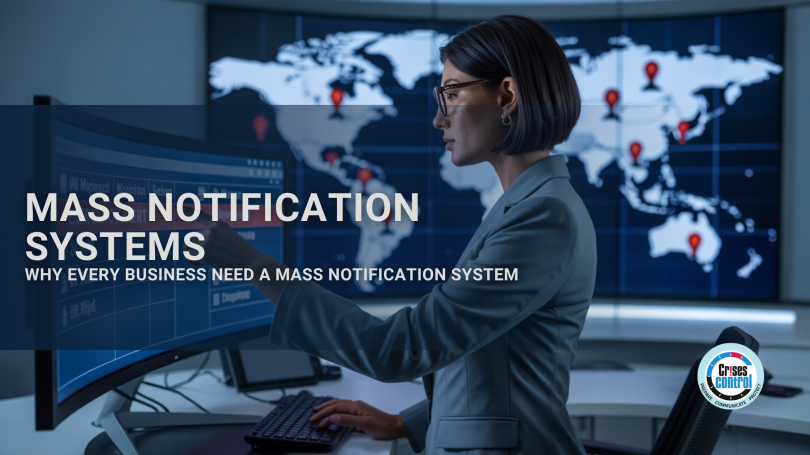Communication lies at the heart of every successful business operation. In the past, businesses relied on conventional methods such as emails, phone calls, and in-person meetings to disseminate information. While these methods are still relevant, they can be slow and ineffective during emergencies or rapidly developing situations.
In today’s digital age, where businesses operate across various locations and time zones, the need for instant, widespread communication is evident. Mass Notification Systems have evolved to meet this demand, providing organizations with a powerful tool to communicate critical information swiftly, efficiently, and comprehensively. In this blog, we’ll delve into why Mass Notification Systems are an indispensable asset for every business in the digital age.
The Essence of Mass Notification Systems
Mass Notification Systems, often abbreviated as MNS, are advanced communication platforms designed to send urgent messages to a large number of people simultaneously. These systems encompass a wide range of communication channels, including SMS, email, voice calls, mobile apps, and more. Here’s why they’re indispensable:
Speed and Reach
In times of crisis, every second counts. MNS allows businesses to send alerts and updates to their employees, customers, or other stakeholders within seconds, regardless of their location. This rapid response can make a significant difference in mitigating the impact of critical events.
Flexibility and Customization
Crises come in various forms, each requiring a specific set of actions and information to address effectively. A natural disaster, for instance, necessitates different instructions compared to a cybersecurity breach or a health-related emergency. Recognizing this, MNS platforms offer the ability to tailor messages precisely to the nature of the situation.
- Message Content: With MNS, organizations can craft messages with precision. Whether it’s an evacuation order, a security protocol update, or a pandemic-related announcement, the content can be customized to convey the exact information needed. This ensures that recipients receive clear, relevant, and actionable instructions.
- Audience Segmentation: Not all messages are meant for everyone. MNS allows for audience segmentation, enabling organizations to send specific messages to particular groups or individuals. For instance, during a weather-related crisis, employees in different geographical locations may receive distinct instructions based on their proximity to the affected area.
- Multi-Channel Delivery: MNS platforms support various communication channels, from SMS and email to mobile apps and voice calls. This flexibility means that messages can be disseminated through the channels that recipients are most likely to check promptly. For example, urgent alerts can be sent via SMS for immediate attention, while detailed instructions can be delivered via email for reference.
- Scheduling and Sequencing: Crises often unfold over time, requiring a sequence of messages to keep recipients informed and safe. MNS allows organizations to schedule messages in advance and automate their delivery based on the evolving situation. This ensures that the right information is conveyed at the right time.
- Language and Format: In an increasingly globalized world, organizations may have multilingual workforces or stakeholders. MNS platforms support messages in multiple languages, accommodating diverse audiences. Additionally, messages can be formatted to be accessible to individuals with disabilities, ensuring inclusivity in communication.
Real-time Monitoring and Feedback
MNS platforms provide real-time monitoring capabilities. This means that organizations can track message delivery, confirm receipt, and even receive responses from recipients. Such features are invaluable for assessing the situation’s status and adjusting the response accordingly.
The Role of MNS in Crisis Management
Effective crisis management is a complex process that involves various elements, including risk assessment, response planning, and communication. MNS serves as a linchpin in this process, enhancing every facet of crisis management:
Early Warning Systems
MNS enables businesses to set up early warning systems that can detect potential crises, such as severe weather alerts, cybersecurity threats, or health emergencies. This proactive approach allows organizations to take preventive measures and reduce risks.
Real-time Updates
During a crisis, the situation can change rapidly. MNS ensures that all stakeholders are kept informed with real-time updates. Whether it’s evacuations, safety procedures, or business continuity plans, MNS keeps everyone in the loop.
Mobilizing Response Teams
In emergencies, response teams must be mobilized swiftly. MNS can instantly alert and assemble the necessary teams, ensuring a coordinated and efficient response to the crisis.
Employee Safety
The well-being of employees is a top priority for any organization. MNS can be used to provide safety instructions, evacuation procedures, and medical assistance details, helping ensure employees’ safety during critical situations.
Conclusion
Mass Notification Systems have evolved to become more than just communication tools; they are essential assets for every business in the digital age.
By embracing the power of Mass Notification Systems, like the one offered by Crises Control, organizations can future-proof their operations, enhance their crisis management capabilities, and, most importantly, protect their most valuable assets—their people. In an era where every second matters, having an MNS in place can make all the difference.
Ready to take the next step in safeguarding your business? Request a live demo or get in touch with our experts to explore how Crises Control’s Mass Notification System can be tailored to your organization’s unique needs. Your preparedness for the digital age begins with us.
